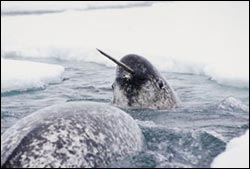Marine Biology Mystery Solved: Function of "Unicorn" Whale’s 8-foot Tooth Discovered

Harvard School of Dental Medicine Researcher Announces Findings Today
Today, Harvard School of Dental Medicine (HSDM) researcher Martin Nweeia, DMD, DDS, answers a marine science question that has eluded the scientific community for hundreds of years: why does the narwhal, or “unicorn,” whale have an 8-foot-long tooth emerging from its head, and what is its function? Nweeia, a clinical instructor in restorative dentistry and biomaterials sciences at HSDM, will be presenting his conclusions at the 16th Biennial Conference on the Biology of Marine Mammals in San Diego.
The narwhal has a tooth, or tusk, which emerges from the left side of the upper jaw and is an evolutionary mystery that defies many of the known principles of mammalian teeth. The tooth’s unique spiral, the degree of its asymmetry to the left side, and its odd distribution among most males and some females are all unique expressions of teeth in mammals. The narwhal is usually 13 to 15 feet in length and weighs between 2,200 and 3,500 pounds. Its natural habitat is the Atlantic portion of the Arctic Ocean, concentrating in the Canadian High Arctic: Baffin Bay, Davis Strait, and northern Hudson Bay. It is also found in less numbers in the Greenland Sea, extending to Svalbard to Severnaya Zemlya off the coast of Russia.
Nweeia has discovered that the narwhal’s tooth has hydrodynamic sensor capabilities. Ten million tiny nerve connections tunnel their way from the central nerve of the narwhal tusk to its outer surface. Though seemingly rigid and hard, the tusk is like a membrane with an extremely sensitive surface, capable of detecting changes in water temperature, pressure, and particle gradients. Because these whales can detect particle gradients in water, they are capable of discerning the salinity of the water, which could help them survive in their Arctic ice environment. It also allows the whales to detect water particles characteristic of the fish that constitute their diet. There is no comparison in nature and certainly none more unique in tooth form, expression, and functional adaptation.
“Why would a tusk break the rules of normal development by expressing millions of sensory pathways that connect its nervous system to the frigid arctic environment?” says Nweeia. “Such a finding is startling and indeed surprised all of us who discovered it.” Nweeia collaborated on this project with Frederick Eichmiller, DDS, director of the Paffenbarger Research Center at the National Institute of Standards and Technology, and James Mead, PhD, curator of Marine Mammals at the National Museum of Natural History of the Smithsonian Institution.
Nweeia studied the whales during four trips to the Canadian High Arctic. In the past, many theories have been presented to explain the tooth’s purpose and function, none of which have been accepted as definitive. One of the most common is that the tooth is used to display aggression between males, who joust with each other for social hierarchy. Another is that the tooth is a secondary sexual characteristic, like a peacock’s feathers or a lion’s mane.
Nweeia’s findings point to a new direction of scientific investigation. Fewer than 250 papers have been published about the narwhal, and many offer conflicting results. Because of its Arctic habitat and protected status in Canada, the whale is difficult to study. Nweeia has brought together leaders from the fields of marine mammal science, dental medicine, engineering, mathematics, evolutionary biology, anatomy, and histology.
The sensory connections discovered by Nweeia and his colleagues also are capable of tactile ability. Narwhals are known for their “tusking” behavior, when males rub tusks. Because of the tactile sensory ability of the tusk surface, the whales are likely experiencing a unique sensation.
Results from the team’s research already has practical applications; studies about the physical makeup of the tusk, which is both strong and flexible, provide insight into ways of improving restorative dental materials. (An 8-foot-long tooth can yield one foot in any direction without breaking). Nweeia also leads the Narwhal Tooth Expeditions and Research Investigation, founded in 2000, which combines scientific experts with Inuit elders, who have collected notes for hundreds of years, to discover the purpose and function of the narwhal tusk.
“Now that we know the sensory capabilities of the tusk, we can design new experiments to describe some of the unique and unexplained behaviors of this elusive and extraordinary whale,” said Nweeia.
This work was funded by Harvard School of Dental Medicine, the National Geographic Society, Sunstar Butler, the Smithsonian Institution Center for Arctic Studies, Astro-Med Inc., and Fisheries and Oceans, Canada.
Media Contact
More Information:
http://www.hms.harvard.eduAll latest news from the category: Life Sciences and Chemistry
Articles and reports from the Life Sciences and chemistry area deal with applied and basic research into modern biology, chemistry and human medicine.
Valuable information can be found on a range of life sciences fields including bacteriology, biochemistry, bionics, bioinformatics, biophysics, biotechnology, genetics, geobotany, human biology, marine biology, microbiology, molecular biology, cellular biology, zoology, bioinorganic chemistry, microchemistry and environmental chemistry.
Newest articles

How marine worms regenerate lost body parts
The return of cells to a stem cell-like state as the key to regeneration. Many living organisms are able to regenerate damaged or lost tissue, but why some are particularly…

Nano-scale molecular detective
New on-chip device uses exotic light rays in 2D material to detect molecules. Researchers have developed a highly sensitive detector for identifying molecules via their infrared vibrational “fingerprint”. Published in Nature…

Novel CAR T-cell therapy
… demonstrates efficacy and safety in preclinical models of HER2-positive solid tumors. The p95HER2 protein is found expressed in one third of HER2+ tumors, which represent 4% of all tumors….



